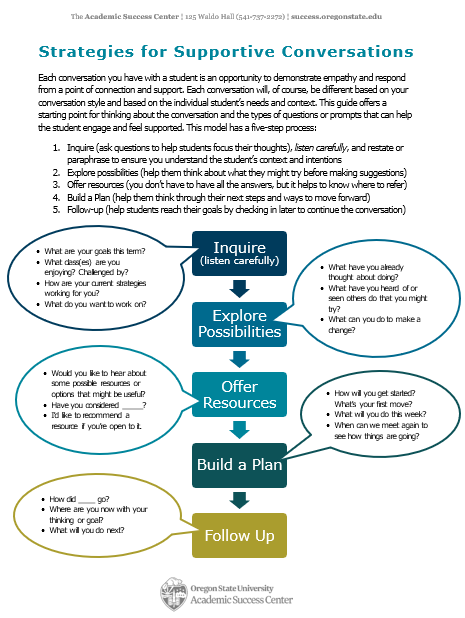by Sarah Norek and Anika Lautenbach
We know that right now, students are experiencing grief, trauma, and overwhelm that make learning difficult. While some students may voice their feelings and experiences, many with similar experiences may not share them. As our colleagues Sara Caldwell-Kan and Bonnie Hemrick pointed out in a recent workshop, we must assume that our students are not okay right now and respond from a point of connection and support.
When we have conversations with students, we have the opportunity to provide empathy and connection and to help students find resources. Over the past few months, we’ve identified some themes and strategies for supporting students in conversation that we’d like to share with you.
Adopting a Supportive Mindset as You Enter the Conversation
- Be a point of connection. Ask how they’re doing and validate their response. Acknowledge you may not have all the answers, but you want to listen.
- Focus on the person in front of you. Whenever possible, eliminate distractions and give your full attention.
- Meet students on their terms. Invite students to engage in ways that feel safe. Don’t insist on video. Keep in mind not everyone is looking for advice. Ask questions to understand how you can support the student.
- Ask questions and come up with solutions together. If students want to explore solutions and strategies, work together to figure out what will work for them.
- Be open and transparent in communication. There is uncertainty in so many parts of life. Be concrete and specific in communication so students don’t need to decipher the message or next steps.
Helping Students Adopt Strategies That Support Their Needs
- Share the Learning during Times of Stress module. The ASC partnered with CAPS to create this Canvas module that helps students learn about and manage stress.
- Help students understand the rhythm of their day. Ask when they are most productive and when they might be able to complete tasks. Help students think about their individual context.
- Talk about the benefits of starting early. Things may take longer than normal right now. Starting early allows students to break tasks into smaller steps to complete over time.
- Support basic needs. Be available to talk about basic needs like food and housing and connect students with resources like the HSRC.
- Normalize self-care. Let students know it’s important to take breaks and it’s ok to need more breaks or longer breaks—especially from the screen. Normalize decisions made on well-being rather than “powering through.” Encourage students to take time for what nourishes them—sleep, connecting with friends, journaling, walking, meditating, etc.
Starting with a Framework
With big topics that impact students’ well-being, it can feel overwhelming at times to plan for or anticipate conversation.  We’ve trained on the Supportive Conversations design for exactly that reason, as it can be helpful to have a sample conversation flow. Click the link or visual for the full-size version. Of course, the conversation needs to be nuanced and adapted to your own style and to the student in front of you, but it offers a starting point for thinking about the flow of a conversation and your role in it.
We’ve trained on the Supportive Conversations design for exactly that reason, as it can be helpful to have a sample conversation flow. Click the link or visual for the full-size version. Of course, the conversation needs to be nuanced and adapted to your own style and to the student in front of you, but it offers a starting point for thinking about the flow of a conversation and your role in it.
Chris Gasser, Coordinator of Supplemental Instruction, notes that “There are multiple pieces of this structure that I appreciate: It is simple, it checks my gut reaction to talk and find solutions, it attends to both the affective and the practical, it gives me a role to play: confidante and thought-partner, and it allows the conversation to continue.”
The strategies in this post and handout aren’t the only ones you can use; we hope these ideas spark new ones for how you can support students you connect with. Our colleagues Sara Caldwell-Kan and Bonnie Hemrick recently offered a webinar on “Centering Care during Uncertainty” and their handout on supporting student employees and leaders provides some great strategies and ideas as well.
In closing, we want to acknowledge that, like our students, many of us are also experiencing grief, trauma, and associated challenges. It’s difficult to offer support if we’re not taking care of ourselves. Please consider how the strategies we’ve shared might also apply to you. And check out Beyond Benefits for employee resources relating to wellness, mental health, finances, and more.
Take care. We’re wishing you well and we’re ready to help you support students in fall term.

